Mars Rover "Spirit" Images
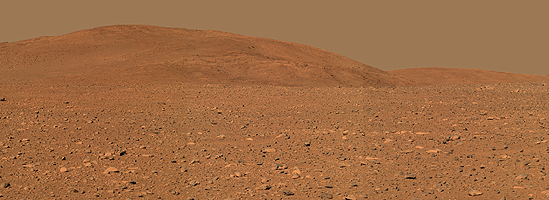
This approximate true-color rendering of the central part of the "Columbia
Hills" was made using images taken by NASA's Mars Exploration Rover Spirit
panoramic camera. Scientists plan to use the science instruments on the
rover to analyze the composition of rock and soil at the hills," Spirit's
planned destination. The images in this mosaic, acquired on sol 149 (June 3,
2004), were taken with the camera's 600, 530, and 480 nanometer filters from
three rover positions approximately 300 meters (984 feet) away from the base
of the hills.
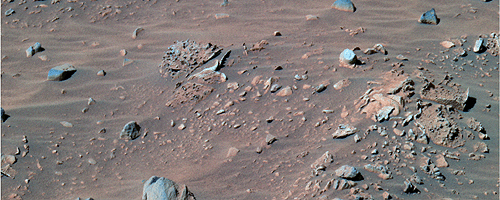
This false-color image taken by the panoramic camera on the Mars Exploration
Rover Spirit shows the rock dubbed "Pot of Gold" (upper left), located near
the base of the "Columbia Hills" in Gusev Crater. Scientists are intrigued
by this unusual-looking, nodule-covered rock and plan to investigate its
detailed chemistry in coming sols. This picture was taken on sol 159 (June
14, 2004).
To the right is a set of rocks referred to as "Rotten Rocks" for their
resemblance to rotting loaves of bread. The insides of these rocks appear to
have been eroded, while their outer rinds remain more intact. These outer
rinds are reminiscent of those found on rocks at Meridiani Planum's "Eagle
Crater." This image was captured on sol 158 (June 13, 2004).

This image taken by the panoramic camera on the Mars Exploration Rover
Spirit shows a trench dug by the rover on its way toward the "Columbia
Hills." Measurements taken of the soil contained in the trench by Spirit's
alpha particle X-ray spectrometer showed the presence of sulfur and
magnesium. Concentrations of those two elements varied in parallel at
different locations in the trench, suggesting that they may be paired as a
magnesium-sulfate salt. One possible explanation for these findings is that
water percolated through underground material and dissolved out minerals,
then as the water evaporated near the surface, it left concentrated salts
behind.

NASA's Mars Exploration Rover Spirit took the images that make up this
360-degree mosaic anaglyph with its navigation camera on sol 156 (June 11,
2004). The image, projected at a cylindrical perspective, highlights
Spirit's arrival at the base of the Columbia Hills. Since landing at Gusev
crater, Spirit has put more than 3.4 kilometers (2.1 miles) on its odometer.
Much of this can be attributed to the long drives the rover had to undertake
to reach these interesting landforms.
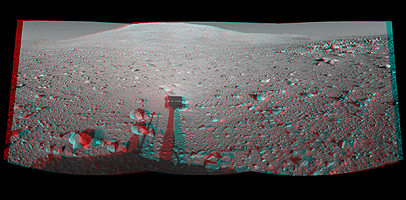
This cylindrical-perspective stereo mosaic was created from navigation
camera images acquired by NASA’s Mars Exploration Rover Spirit during
Spirit's sol 153, on June 8, 2004. Spirit is pointing toward the base of the
"Columbia Hills."

This 360-degree stereo anaglyph of the terrain surrounding NASA's Mars
Exploration Rover Spirit on the 148th martian day of the rover's mission
inside Gusev Crater, on June 2, 2004, was assembled from images taken by
Spirit's navigation camera. The rover's position is Site A61. The view is
presented in a cylindrical-perspective projection with geometrical seam
correction.

This enhanced false-color mosaic image from the Mars Exploration Rover Spirit panoramic
camera shows the view acquired after the rover drove approximately 50.2 meters (165 feet)
on the martian afternoon of sol 89 (April 3, 2004). The view shows the direction of the
rover's future drive destination. In the distance are the eastern-lying "Columbia Hills."
This image was assembled from images in the panoramic camera's near-infrared
(750 nanometer), green (530 nanometer), and violet (432 nanometer) filters. The colors
have been exaggerated to enhance the differences between cleaner and dustier rocks, and
lighter and darker soils.
Full Resolution Version (3.7 Mb)
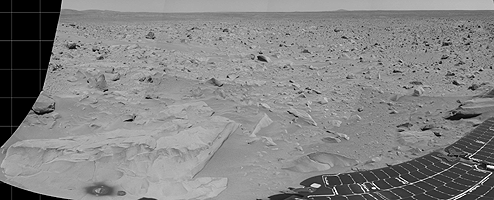
This cylindrical mosaic taken by the navigation camera on the Mars Exploration Rover
Spirit on sol 82 shows the view south of the large crater dubbed "Bonneville." The
rover will travel toward the Columbia Hills, seen here at the upper left. The rock
dubbed "Mazatzal" and the hole the rover drilled in to it can be seen at the lower
left. The rover's position is referred to as "Site 22, Position 32." This image was
geometrically corrected to make the horizon appear flat.
Red/Blue 3-D Version

The rim and interior of a crater nicknamed "Bonneville" dominate this 180-degree,
false-color mosaic of images taken by the panoramic camera of NASA's Mars Exploration
Rover Spirit. Spirit recorded this view on the rover's 68th sol, March 12, 2004, one
sol after reaching this location. The rover remaining here in part to get this very
high-resolution, color mosaic, from which scientists can gain insight about the depth
of the surface material at Bonneville and make future observation plans. The light
blue object on the far rim of the crater is Spirit's heat shield.
Full Resolution Version

On the 66th martian day, or sol, of its mission, the Mars Exploration Rover
Spirit finished a drive and sent back this navigation camera image mosaic
revealing "Bonneville" crater in its entirety.
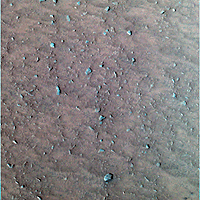
This image shows the patch of soil at the bottom of the shallow depression dubbed
"Laguna Hollow" where the Mars Exploration Rover Spirit will soon begin trenching.
Scientists are intrigued by the clustering of small pebbles and the crack-like
fine lines, which indicate a coherent surface that expands and contracts. A number
of processes can cause materials to expand and contract, including cycles of
heating and cooling; freezing and thawing; and rising and falling of salty liquids
within a substance. This false-color image was created using the blue, green and
infrared filters of the rover's panoramic camera. Scientists chose this particular
combination of filters to enhance the heterogeneity of the martian soil.

This image shows the shallow depression dubbed "Laguna Hollow" before the Mars Exploration
Rover Spirit drove into it to sample its bed of fine sediments on the 45th sol or day, of
its mission (Feb. 18, 2004). The hollow provides scientists with a laboratory for studying
the atmospheric processes that shaped Mars because, in contrast to surrounding rocky terrain,
it contains windblown dust and possibly salty clumps of soil. Spirit is scheduled to dig a
trench at the bottom of "Laguna Hollow" on sol 47. The image was taken by the rover's
panoramic camera.

In the distance stand the east hills, which are closest to the Mars Exploration Rover Spirit
in comparison to other hill ranges seen on the martian horizon. The top of the east hills are
approximately 2 to 3 kilometers (1 to 2 miles) away from the rover's approximate location.
This image was taken on Mars by the rover's panoramic camera.

This 360-degree mosaic panorama image, taken by the navigation camera on the Mars Exploration Rover Spirit,
includes a view of the lander. The lander is located to the south-southwest of the rover, which is moving
toward a crater nicknamed "Bonneville. Sleepy Hollow can be seen to the right of the lander. As of Sol 44,
which ended on February 17, 2004, the rover had moved a total of 106.6 meters (350 feet) since leaving the
lander on January 15, 2004. This image was taken on Sol 39 (February 11, 2004).
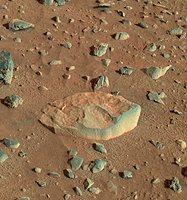
This is a composite red-green-blue image of the rock called White Boat. It
is the first rock target that Spirit drove to after finishing a series of
investigations on the rock Adirondack. White Boat stood out to scientists
due to its light color and more tabular shape compared to the dark,
rounded rocks that surround it.
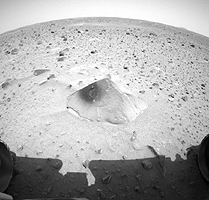
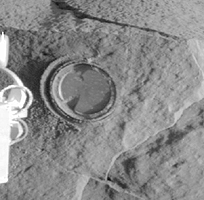
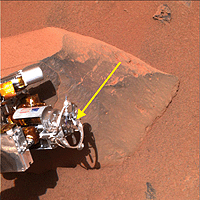
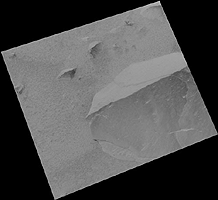
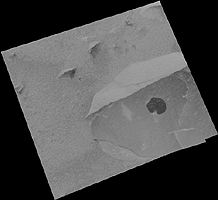
Images showing the hole drilled in Adirondack by the Rock Abrasion Tool (RAT), and the RAT next to Adirondack
where it was first used to remove dust from the surface, as shown in the before and after images.
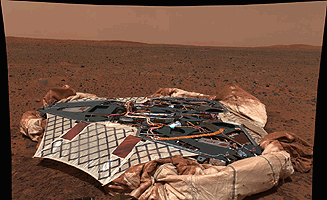
This image mosaic taken by the panoramic camera onboard the Mars Exploration Rover Spirit shows the rover's
landing site, the Columbia Memorial Station, at Gusev Crater, Mars. This spectacular view may encapsulate
Spirit's entire journey, from lander to its possible final destination toward the east hills. On its way,
the rover will travel 250 meters (820 feet) northeast to a large crater approximately 200 meters (660 feet)
across, the ridge of which can be seen to the left of this image. To the right are the east hills, about 3
kilometers (2 miles) away from the lander. The picture was taken on the 16th martian day, or sol, of the
mission (Jan. 18/19, 2004). A portion of Spirit's solar panels appear in the foreground. Data from the
panoramic camera's green, blue and infrared filters were combined to create this approximate true color image.
Full Resolution Version
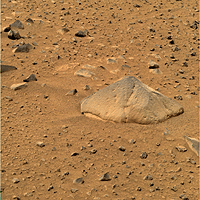

Image of the rock nicknamed "Adirondack" and an image of the rover arm moving
towards it.
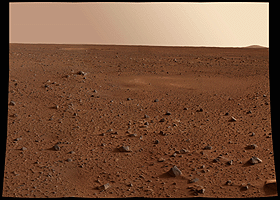
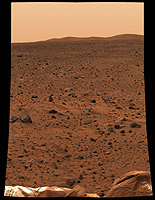
Views of Spirit Rollout Onto the Surface of Mars
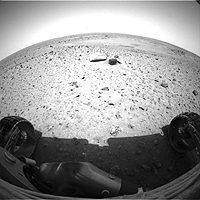
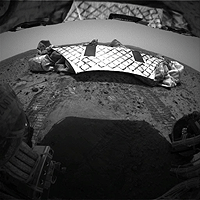
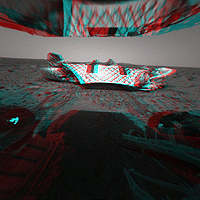
Views from the Spirit Rover after rollout onto the martian surface looking forward,
looking back at the landing platform, and the landing platform in 3D
Full Panorama of Landing Site

Views of the Airbag Drag Marks near Spirit
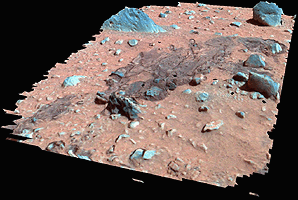
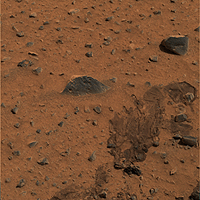
(Left) A three-dimensional color model created using data from the
Mars Exploration Rover's panoramic camera shows images of
airbag drag marks on the martian surface. The triangular rock in
the upper left corner is approximately 20 centimeters (8 inches)
tall. The meatball-shaped rock in the upper right corner is
approximately 10 centimeters (4 inches) tall. The dark portion of
the surface, or "trough" is approximately 1 centimeter (0.4 inches)
deep at its deepest point.
(Right) This section of the first color image from the Mars Exploration
Rover Spirit has been further processed to produce a sharper
look at a trail left by the one of rover's airbags. The drag mark
was made after the rover landed and its airbags were deflated
and retracted. Rocks were also dragged by the airbags, leaving
impressions and "bow waves" in the soil. The mission team plans
to drive the rover over to this site to look for additional clues
about the composition of the martian soil.
Image from the Landing Site Looking Southwest
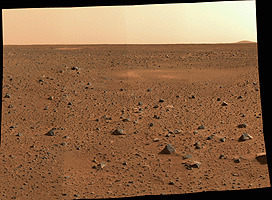
This image mosaic taken by the Mars Exploration Rover Spirit's
panoramic camera shows a new slice of martian real estate
southwest of the rover's landing site. The landscape shows little
variation in local topography, though a narrow peak only seven to
eight kilometers away is visible on the horizon. A circular
depression, similar to the one dubbed Sleepy Hollow, can be seen
in the foreground. Compared to the
Viking and Pathfinder landing sites the terrain at Gusev Crater, Spirit's landing site, is flat
and speckled with a sparse array of rocks.
(Full Resolution Image - 2.8 Mb)
Image from Landing Site Looking North
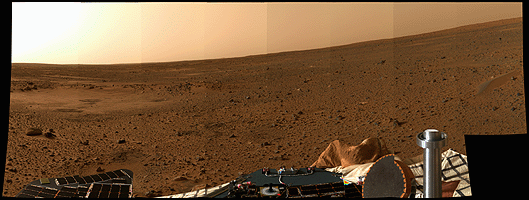
(Full Resolution Image - 4.2 Mb)
Stereo Image of Gusev Crater
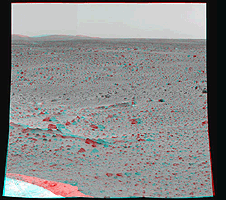
First Color Mosaic From Gusev Crater, Mars
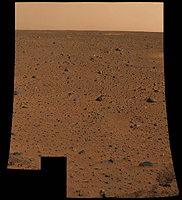
This is the first color image of Mars taken by the panoramic camera on the Mars Exploration
Rover Spirit. It is the highest resolution image ever taken on the surface of another planet.
(Full Resolution Image - 2.5 Mb)
First Press Release Images From Gusev Crater, Mars

Improved mosaic image taken by the navigation camera on the Mars Exploration Rover Spirit
showing a 360 degree panoramic view of the rover on the surface of Mars.
Brightness enhanced version of the image

Red-blue stereo mosaic image showing a 360 degree panoramic view of the rover on the
surface of Mars.

This mosaic image taken by the navigation camera on the Mars Exploration Rover Spirit
shows a 360 degree panoramic view of the rover on the surface of Mars.
Brightness enhanced version of the image
Images and captions courtesy NASA/JPL
 More Images from the Descent and Landing
More Images from the Descent and Landing
 First Images from "Opportunity" at Meridiani Planum
First Images from "Opportunity" at Meridiani Planum
 Comparison of Spirit, Mars Pathfinder, and Viking Panoramas
Comparison of Spirit, Mars Pathfinder, and Viking Panoramas
 Press Release on the Landing and First Images - 4 January 2004
Press Release on the Landing and First Images - 4 January 2004
 Mars Rover "Spirit" home page at NSSDC
Mars Rover "Spirit" home page at NSSDC
![[NASA Logo]](/logo/nasa_logo.gif) Author/Curator:
Author/Curator:
Dr. David R. Williams, dave.williams@nasa.gov
NSSDCA, Mail Code 690.1
NASA Goddard Space Flight Center
Greenbelt, MD 20771
+1-301-286-1258
NASA Security and Privacy Statement
NASA Official: Dave Williams, david.r.williams@nasa.gov
Last Updated: 09 march 2005, DRW






































 More Images from the Descent and Landing
More Images from the Descent and Landing ![[NASA Logo]](/logo/nasa_logo.gif) Author/Curator:
Author/Curator: